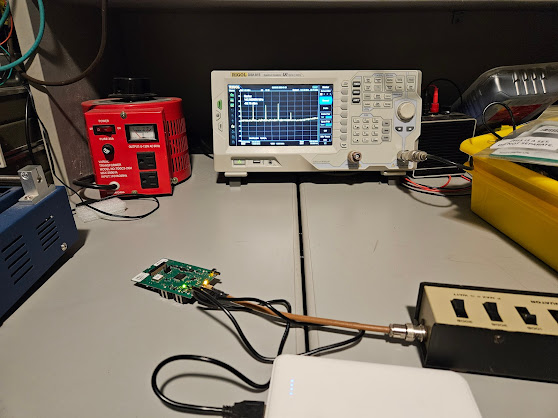The Experiment
I put on my lab coat, started boiling some test tubes, and made a few bwoo-hahaha noises tonight, as I did some science. I attached an SMA connector to one of my DFM-17's so that I could run some controlled experiments of RS41ng on both 2m vs 70cm. The intent was to verify whether the output RF filters on the DFM-17 are appropriate for transmitting beacons on the 2m band.
Modifying the DFM-17
I removed the stock antenna and added an SMA connector on the provided pads. The board layout was standard, and an SMA connector in my parts bin fit just fine.
The test setup
I then cabled the DFM-17 through a pushbutton attenuator and added 40db of attenuation in the path to my Spectrum Analyzer (I didn't want to overdrive the input). Note, the pushbutton attenuator I was using is built for 75 ohm, not 50 ohm. This may impact some output power readings, but it should be consistent across frequencies, so while the output measured may not be exact, the relative powers and presence (or lack) of harmonic signals should be close enough for folk music and ham radio.
70cm Measurement
I then took a look at the spectrum when running at Horus Binary and APRS on 70cm. I had the Spectrum Analyzer set to full scale (0-1500 mhz). Note there were no harmonics in evidence at all. The filters on the board seemed to do an admirable job of keeping it clean. The SA showed -15 db. Adding the 40db of attenuation, it's making about 25dbm of output. Ish.
2m Measurement
I then re-flashed the code to beacon APRS at 144.390, and transmit Horus Binary at 145.600. Note the harmonics generated. The filtering on the board appears to be a low pass filter tuned to 70cm So the harmonics below 400 mhz are coming through loud and clear. There does seem to be some attenuation, as the signal on 144.390 is showing 10db weaker than the 70cm test). The first and second harmonics have pretty strong relative output power, since they are presumably going through less attenuation as the frequencies increase. There could be some variability in the output power of the Si4063 chip at different frequencies as well. Note that the harmonic up in the 70cm frequency range is even stronger than the base signal at 2m, due to the vagaries of the filtering.
Conclusions
Running the DFM-17 below 70cm is going to transmit unwanted harmonics. Though the overall output power is low, down in the 15dbm range, this would be generated by a balloon aloft, meaning the harmonics will be broadcast for pretty much line of sight across quite a significant radius. I would advise against doing it unless you modify the filtering on the board. The DFM-17 seems VERY nicely tuned for signals on 70cm, however. I was quite pleased to see the results there.
Mike / KD2EAT


No comments:
Post a Comment